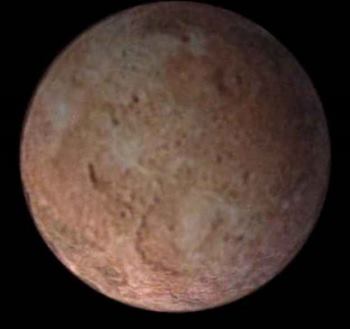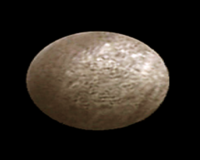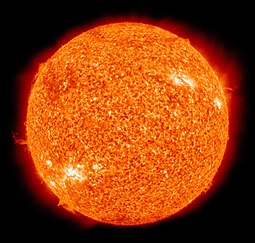Ixion is a large trans-Neptunian object. It is located in the Kuiper belt, a region of icy objects orbiting beyond Neptune in the outer solar system. Ixion is classified as a plutino, a dynamical class of objects in a 3:2 orbital resonance with Neptune. Trace amounts of water have been identified on Ixion’s surface, implying that most of the water ice there is likely to be hidden underneath a thick layer of organic compounds on its surface. This causes the planet to appear red in the visible spectrum.
Ixion has a measured diameter of 710 km (440 mi), making it the fourth-largest known plutino. Several astronomers are considering that Ixion may be a dwarf planet because it is large enough to have assumed a round shape caused by hydrostatic equilibrium, although studies in 2019 suggest that objects around the size of Ixion may retain significant internal porosity and thus represent a transitional zone between Small Solar System Bodies and dwarf planets. This transitional zone of small solar system bodies (SSSBs), including Pluto, represents the part of our consciousness that delivers us from the 3D realm to 5D consciousness. Small Solar System Bodies were given their own classification in 2006. Ixion is currently not known to have a natural satellite; thus its mass and density remain unknown.
Ixion was discovered on 22 May 2001 by a team of American astronomers at the Cerro Tololo Inter-American Observatory in Chile, and introduced to the world in July 2001. At the time of discovery, Ixion was located in sidereal Scorpio (in the constellation of Ophiuchus), and was positioned in an opposition (bridge) with Saturn in Taurus, with the Sun approaching Saturn. This suggests the theme of becoming responsible for one’s actions.
The discovery supported suggestions that there were undiscovered large trans-Neptunian Objects (TNOs) comparable in size to Pluto. Since Ixion’s discovery, numerous large TNOs, notably the dwarf planets Haumea, Eris, and Makemake, have been discovered; in particular, Eris is almost the same size as Pluto.
From the beginning, Ixion was thought to be among the largest TNOs in the Solar System, as implied by its high intrinsic brightness. With regard to this brightness, Nick Fiorenza pointed out the presence of three potent binary neutron stars that were discovered upon further observation. These stars are X-ray sources that express into this few degree area of the ecliptic: Hercules X-1, Scorpio X-1, and Circini X-1. Their intense X-ray emissions excite a high-vibrational resonance beyond the visible realm of light that supports personal transmutation into a greater level of self-awareness.
In August 2001, a team of astronomers obtained nine precovery images of Ixion, with the earliest taken on 17 July 1982. These images, along with subsequent follow-up observations in 2001, extended Ixion’s observation arc by over 18 years, sufficient for its orbit to be accurately determined. Ixion was given the permanent minor planet number 28978 on 2 September 2001.
Ixion orbits the Sun at an average distance of 39.8 AU, taking 251 years to complete a full orbit. This is characteristic of all plutinos, which have orbital periods around 250 years and semi-major axes around 39 AU.
Like Pluto and all bodies that represent the 5D consciousness, Ixion’s orbit is elongated and inclined to the ecliptic. Ixion has an orbital eccentricity of 0.24 and an orbital inclination of 19.6 degrees, slightly greater than Pluto’s inclination of 17 degrees. Although Ixion’s orbit is similar to that of Pluto, their orbits are oriented differently: Ixion’s perihelion (closest distance to the Sun) is below the ecliptic, just out of the realm of our waking consciousness, whereas Pluto’s is above it, making it far more accessible to us consciously. Ixion reached perihelion in 1946 and is currently moving away from the Sun. It will approach aphelion (furthest distance) in November 2070.
Due to Ixion’s elongated orbit, it spends more time in certain signs than others. For example, it entered Virgo in 1906 (29 years), Libra in 1935 (31 years), Scorpio in 1966 (30 years), Sagittarius on 12/13/95 (24 years), and Capricorn on 2/25/2020; it will spend 19 years in that sign before entering Aquarius on 12/19/2039, just in time for all the Aquarian ingresses and the birthing of the new world.
This Kuiper Belt object is named after the Greek mythological figure Ixion, in accordance with the International Astronomical Union’s (IAU’s) naming convention which requires plutinos to be named after mythological figures associated with what we have long considered the underworld.
In Greek mythology, Ixion was a descendant of Ares, and he was the king of the legendary Lapiths of Thessaly. He had married Dia, a daughter of King Deioneus (or Eioneus), promising to give valuable bridal gifts to the King. But he reneged, and the King retaliated by stealing Ixion’s mares. Enraged, Ixion plotted his revenge by inviting Deioneus to a banquet, where he pushed him into a pitfall of burning coals and wood, killing him.
Although the lesser gods despised his actions, Zeus pitied Ixion and invited him to a banquet with other gods. Rather than being grateful, Ixion became lustful towards Zeus’s wife, Hera. Zeus found out about his intentions and created the cloud Nephele in the shape of Hera, and tricked Ixion into coupling with it, fathering Centaurus. Centaurus later mated with the mares of Mt. Pelion, producing the race of Centaurs (not including Chiron). This makes Ixion the grandfather of the centaurs. For his crimes, Ixion was expelled from Olympus, blasted with a thunderbolt, and bound to a burning solar wheel in the underworld for all eternity.
This ‘punishment’ is clearly a metaphor for being bound to the karmic wheel of reincarnation. The 5D expression of Ixion has everything to do with one’s awareness (or lack thereof) of their karmic plight, and the ultimate decision, which comes repeatedly within every incarnation, to choose to rectify one’s mistakes once and for all.
Nick Fiorenza observes: “I find the theme here diverse, with twists of financial and sexual exploitation, deceit, delusion, and karmic retribution. This is one of uncontrolled righteous rage carried from a long standing warring and arrogant time-stream of consciousness (Ixion being a descendent of Ares). It is of deliberate deception and retaliation between two authoritarian figures (King Ixion of the Lapiths versus King Eioneus of Thrace). It has an element of deliberately causing death (through fire). It has an element of a female (princess Dia) being treated as property, owned and stolen; i.e., feminine or sexual exploitation. It reveals a long drawn-out karmic scenario: Ixion takes Eioneus’ daughter Dia and then deceives and kills Eioneus with the karmic payback provided by Zeus after Ixion once again demonstrates his deliberately deceptive intent. But this time Ixion is lost in his own deception to pursue only an illusory image of Hera.”
This long standing issue of ‘uncontrolled righteous rage’ affects us all at the level of collective unconsciousness, and continues to play out today, pointing to the Truth that everything here in this 3D world has the potential to trap us in illusion. How each individual responds to this energy is a matter of conscious choice. It reveals that the decision to focus on the higher Self can lift one up above the fray. Rage is a fear-based reaction that stems from a lack of awareness and unconsciousness. Once one becomes aware of being in the throes of this emotion, the choice can be made to deliberately direct the consciousness to higher ground, bringing Love into the mix. Love is the only way to neutralize the karma that fear-based action manifests.
Ixion represents the purpose the soul has for coming into physical form in this lifetime: to correct karmic imbalances. Whether or not one undertakes this effort is an individual choice that depends upon one’s level of conscious discipline and devotion to the higher Self. The individual who has not yet become aware of the Path will be more inclined to repeat past karmic circumstances, which are always designed to offer the opportunity to awaken. The transiting Ixion represents the same collective purpose: to learn to choose to take the Path to Self-realization.
Ixion is one of many plutinos, and Pluto is the first of these bodies (such as Orcus, Arawn, and others) that have an orbit with a 3:2 ratio to Neptune’s orbit. That is, Neptune takes 165 years to orbit the zodiac once, while the plutinos take about 250 years to do the same. This 3:2 ratio has everything to do with the new consciousness. Neptune is the outermost planet in our solar system, and the plutinos are gathered together at the beginning of the Kuiper Belt to bring consciousness into the higher frequency of the outer realm, the 5D consciousness, taking us from 3 to 2. Three represents the conscious manifestation required to move through the illusion of the Neptunian realm. The awakened consciousness is ultimately ONE. The Self-realized, conscious soul experiences the Self as the mirrored Self, and understands that all is a reflection of one’s own Being. It is a well known higher Teaching that there is no duality except the duality required to experience Love. All plutinos provide a connection to the higher, immortal eternal Self.
The soul has a fully awakened consciousness before embodying, and whether or not it can achieve and maintain that level of awareness in human form is up to the individual.
As a 5D planet, Ixion functions at the level of the new consciousness. It can assist in raising each person’s awareness to the place where it has more of an opportunity to achieve the goal set by the soul itself before it incarnates. In the natal chart, Ixion speaks to the soul’s desire to correct a repetitive karmic cycle, hopefully once and for all, in this lifetime. Just what that cycle is turns out to be the same, and completely different, for each of us. In the biggest picture, It is a collective devotion to the evolution that creates a new world, and it is also a very individualized way of doing just that, distinctly unique to each of us. Any aspect made to Ixion in the birth chart reveals the work that is required to achieve karmic balance in this lifetime. Whether or not one chooses to undertake this effort is utterly up to the individual itself: to clear the karmic slate or commit to another cycle. Each choice creates possibilities for other choices to emerge.
The transiting Ixion deals with the collective journey of every soul here on the planet. Ixion relates to certain evolutionary milestones, and these are usually the kinds of things that were not achieved in past lives, though they were attempted. Wherever the transiting Ixion is located represents the issue that the collective consciousness of humanity is working on. Whenever the transiting Ixion aspects the natal chart, it points to the individual issues that are connected to the collective purpose. Whenever the transiting Ixion aspects another 5D planet, it signifies an opportunity to work with one of those areas that need our attention collectively, and for a prolonged period.
Natally and by transit, Ixion provides the chance to correct anything that was out of integrity or worse in past lifetimes. It’s that effort the soul means to put into the lifetime to get something done that it hasn’t been able to do yet, not for the lack of trying.
Ixion has been traveling within a few degrees of Quaoar for more than 80 years, and will continue to do so for another 25 – 30 years. That means everyone alive on the planet today has the opportunity to achieve something very much related to Quaoar. Quaoar is the capacity to perceive entirely new thoughts and beliefs, and therefore to manifest a new world. Consequently, every soul on the planet right now can choose to expand and elevate its own conscious awareness, the higher Mind. Because this is a generational transit, its long term aspect provides humanity with an outstanding chance to evolve into a new kind of experience.
Ixion spends half the year retrograde and the other half direct. This is very important because a retrograde cycle provides the space to realign and resurrect the patterns and thoughts that we have most recently undertaken. If we have made wrong choices, or begun to repeat old patterns, the long retrograde cycle gives us the chance to observe and redirect our energies. Ixion goes retrograde each year in the spring and turns direct in the Fall.
Despite the fact that the commonly used Solar Fire program does not contain the true symbol for Ixion, (it is represented by a lowercase a in that program), the most utilized symbol for the planet is depicted above. There are others, but this one makes the most sense, since it represents a fiery spinning wheel, which is what Zeus condemned Ixion to when he got caught with the mirage of Hera that was created to trap him. In a sense, as humans, we are all attached to a fiery wheel, the wheel of karma; and it is up to us, as we awaken, to repeatedly make the choice to become fearless and leave the wheel behind. This is, more than anything, an evolutionary process. It takes many lifetimes, but we are at a point where it is becoming possible to make this choice as a collective unified consciousness, thereby creating a brand new world.




